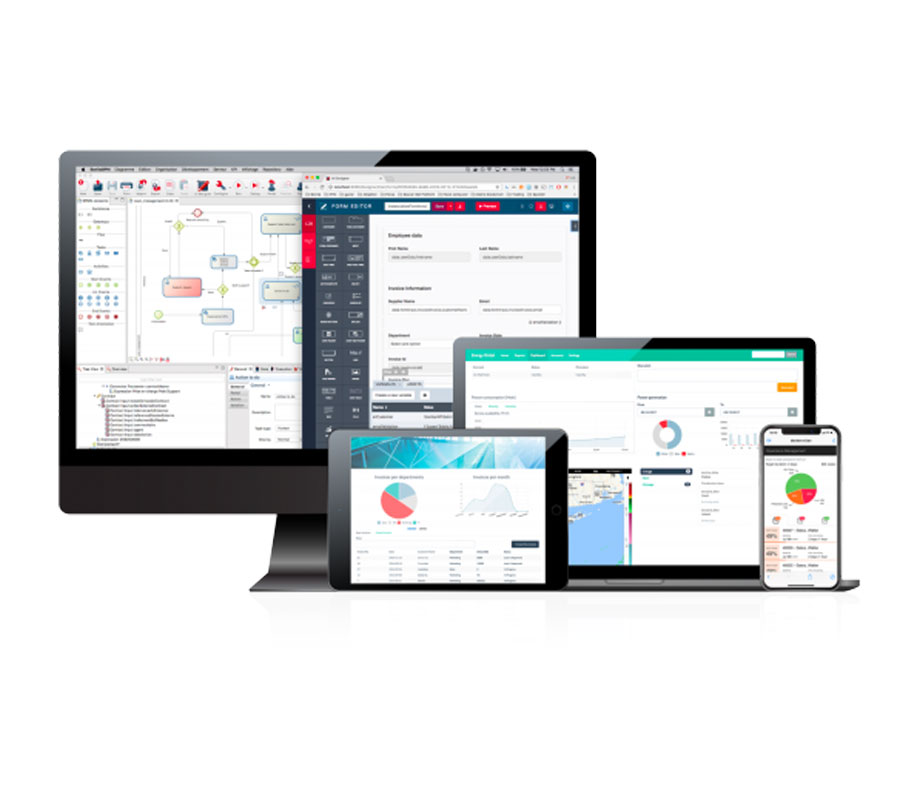BPM self contained apps to improve agility and competitiveness
Tuesday, April 18, 2023

|
Pablo Alonso de Linaje |
Pablo Alonso de Linaje discusses BPM self-contained applications, how they improve agility and competitiveness, what it takes to shift, the benefits of BPM and containerization, plus the perspectives on self-contained apps from BPM based and DevOps developers, and platform providers.
The needs and objectives of business evolve fast, and continuously, in a competitive environment. This places a heavy demand on enterprise IT teams to develop and deliver and change business applications rapidly.
BPM self-contained applications offer a new approach to business process management (BPM) process-based applications. This approach aims to simplify the application installation and deployment process by bundling the BPM platform-created app and its runtime environment together into a single package, the concept behind containerization.
BPM self-contained apps
BPM software is designed to automate and optimize workflows. Currently, available BPM platforms are widely used by companies and other organizations for business process applications, and their architecture has an influence on how agile DevOps can be. Application development teams have already seen improved agility and efficiency using the BPMN2.0 standard visual model for process modeling, and platform extensibility through services orchestration, and APIs. Now we are analyzing ways to increase the agility of the Operations team for delivering and managing these applications.
The potential of BPM + containerization
Traditional BPM application automation platforms require the installation and configuration of complex infrastructure, which frankly can be a barrier to adoption for some organizations.
The idea behind the self-contained apps approach is to combine the benefits of the capabilities of a BPM platform for app development with the containerization approaches and technologies for deployment.
Containerization is already becoming a widely accepted standard for DevOps teams, and managing on-premise deployments is now a totally different story using container technologies. Generally, app deployment and management are becoming easier and cheaper. Dev teams now have everything they need to operate more smoothly by leveraging container-related technologies such as Docker and Kubernetes.
With containerization, DevOps teams can deploy individual process-based apps independently of the shared platform resources. This means it’s possible to deliver faster, scale each application as needed, and maintain one app at a time without disturbing other high-availability apps, for better organizational agility to deliver value (i.e. improvements) as quickly as the business requires.
In theory, BPM self-contained applications offer benefits in terms of flexibility, reusability, and ease of maintenance due to their self-contained nature, but there is currently little research on self-contained business process applications and their impacts and limitations.
To demonstrate the potential benefits of BPM self-contained applications, it’s useful to test and validate their performance and effectiveness compared to other types of BPMS applications. One way to do this is to design and implement BPM self-contained applications in real-world business environments and evaluate their outcomes with surveys and interviews with users and developers to gain insights into their experiences.

What does it take to shift from a BPM platform to a self-contained application approach?
Our R&D team has looked into the impact of moving from a centralized BPM platform to self-contained applications from the perspective of both developers and DevOps teams. This research indicates that while the self-contained approach offers significant benefits in terms of agility and flexibility, it also introduces additional operational overhead in managing multiple self-contained applications. We identified several challenges from the development and DevOps perspectives. These highlight some of the key considerations that BPM platform providers and the organizations that use them should keep in mind.
The BPM-based application developers' perspective
- Modularization: One of the significant changes when moving to a self-contained app-only approach is that existing BPM applications would have to be broken down into smaller, self-contained apps. This is likely to be time-consuming and resource-intensive, requiring a significant effort from the development team to re-architect existing BPM applications to meet the new architecture requirements. A phased approach that would permit new applications to be self-contained while still maintaining existing apps as-is would help mitigate this concern.
- Interface and contract definition: Development teams must define clear interfaces and contracts to ensure seamless interoperability between self-contained apps, as the dependencies between them will change with the new architecture. These interfaces must be carefully designed and tested to ensure that the overall system functions as intended.
- Resource management: In a self-contained app approach, each app may require its own resources, such as databases, messaging systems, and other infrastructure components. Development teams must consider where and how to share resources between apps to avoid duplication and ensure optimal resource utilization.
The DevOps perspective
- Multiple installations: With a self-contained app approach, there may be multiple installations of the same app running on different servers. DevOps teams will need to manage, monitor, and troubleshoot issues across all installations.
- Deployment complexity: Deploying multiple self-contained apps can be more complex than deploying a single platform. DevOps teams must consider how to deploy apps in a consistent, repeatable way to avoid errors and ensure reliability.
- Operational costs: Deploying and supporting multiple self-contained apps may require an increased number of infrastructure components, which can lead to higher operational costs.

The BPM platform providers' perspective
Identifying the challenges and considerations involved in transitioning from a platform to a self-contained approach for BPM applications is just a first step. BPM software providers looking to adopt a self-contained applications approach must also take proactive steps to reduce constraints, to ensure that their users can make the most of the new architecture. Some of the key areas where BPM platform providers can focus their efforts include:
- Monitoring: In a self-contained app environment, monitoring becomes more complex, as there are more individual components to track and troubleshoot. BPM platform providers should provide tools to monitor the performance and health of each individual app, as well as the overall system. A kind of “Application Central” capability can include real-time monitoring dashboards, log aggregation, and alerting capabilities.
- Configuration: With a self-contained app approach, there may be multiple configurations to manage across different apps and environments. BPM providers can simplify configuration management by providing centralized tools to define and manage configurations for each app consistently and efficiently. These can include support for version control, rollbacks, and auditing.
- Deployment and orchestration: Deploying multiple self-contained apps can be complex when coordinating deployment across different environments and managing dependencies between apps. BPM providers can provide tools and frameworks that simplify deployment and orchestration, such as containerization, Kubernetes, and Helm charts.
- Integration and interoperability: In a self-contained app approach, the dependencies between apps are more explicit and defined, which can make integration and interoperability more challenging. BPM providers can offer tools and frameworks that simplify integration, such as APIs, message queues, and event-driven architectures. They can also work with other software providers and standards bodies and organizations to define and promote industry-wide interoperability standards.
By paying attention to these areas, BPM providers can help DevOps teams to navigate the challenges of transitioning to a self-contained applications approach to realize the benefits of increased agility and flexibility. They should also provide guidance, documentation, and training to ensure that technical and IT teams have the necessary skills and knowledge to successfully adopt the new architecture.

The move to self-contained applications: validate the value and guide users
Validating the self-contained application approach for BPM projects against actual real-life projects is essential to understand its effectiveness and practicality. While theoretical projects can provide valuable insights and help identify potential benefits and limitations, they do not always accurately reflect the complex and dynamic nature of real-world scenarios. Real-life projects involve a variety of factors, such as multiple stakeholders, changing requirements, and unforeseen challenges.
We have obtained intermediate results through our research that are being validated by external parties. We have begun sharing our analysis and approach to obtain feedback and confirmation on the interpretation of our results.
This includes a program to analyze real-life BPM projects from enterprise and commercial partners who are willing to adopt the new BPM self-contained approach. The research team has defined a means to evaluate the agility of these projects and is collecting data on project performance, including development time, ease of maintenance, and the ability to adapt to changing requirements. We are then able to compare the performance of these projects to traditional platform-managed BPM applications.
By testing the approach in real-life projects, we can better understand its strengths and weaknesses, identify potential areas of improvement, and gain insights into how it can be effectively applied in different contexts to meet the needs and expectations of organizations seeking to improve their BPM practices and agility.
This work will ultimately help organizations to consider the appropriateness of adopting the self-contained applications approach for their specific business needs, so they can make informed decisions about their BPM strategies and improve their agility and competitiveness in an increasingly dynamic business environment.
Overall, it appears that transitioning from a platform to a self-contained app approach requires significant effort and coordination between application development and DevOps teams. While there are benefits to a self-contained app approach, such as increased agility and flexibility, there are also challenges that must be addressed to ensure a successful transition. BPM platform providers will need to provide guidance and support to their customers to help them navigate these challenges and maximize the potential of their new architecture.
About Pablo Alonso de Linaje
Pablo Alonso de Linaje is the Software Development Manager at Bonitasoft, a BPM expert with 20 years of experience. He started at Bonitasoft as a Professional Services Consultant, responsible for designing and implementing complex Bonita applications with IT teams in companies worldwide. Then, as Bonita Product Owner, he led the Bonita runtime team to transform its architecture to benefit maximally from a serverless approach, with a focus on highly scalable on-premise and aPaaS solutions. Now, he works with the entire Bonita development team to deliver ongoing BPM technical and business innovation.

This content is made possible by a guest author, or sponsor; it is not written by and does not necessarily reflect the views of App Developer Magazine's editorial staff.

Become a subscriber of App Developer Magazine for just $5.99 a month and take advantage of all these perks.
MEMBERS GET ACCESS TO
- - Exclusive content from leaders in the industry
- - Q&A articles from industry leaders
- - Tips and tricks from the most successful developers weekly
- - Monthly issues, including all 90+ back-issues since 2012
- - Event discounts and early-bird signups
- - Gain insight from top achievers in the app store
- - Learn what tools to use, what SDK's to use, and more
Subscribe here

_r2f0ox12.jpg&width=800)










